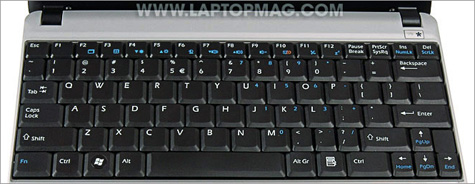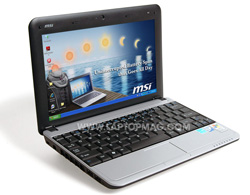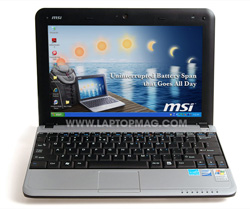Laptop Mag Verdict
This netbook's 12+ hours of battery life is impressive, but the competition offers better designs.
Pros
- +
Extra long battery life
- +
Strong wireless throughput
Cons
- -
Bulky, dated design
- -
Small touchpad
Why you can trust Laptop Mag
MSI was the first netbook manufacturer to impress us with long battery life; the original MSI Wind U100 lasted more than 5 hours when the average netbook was lucky to get to 4. With each new release of the U Series, battery life has remained a priority, reaching beyond 6, 8, and even 9 hours of endurance. The company's updated U110 ($429) continues this trend with a nine-cell battery that offers a whopping 12 hours and 28 minutes of runtime. But while MSI has made strides in endurance, this Wind lags behind its competitors in every other aspect, including design, performance, and price.
Design
Except for the large nine-cell battery jutting underneath, the 10.2 x 7.1 x 1.2 inch U110 has the same basic design as the original MSI Wind U100, right down to the keyboard and small touchpad. The original Wind was a favorite of ours when it came on the market over a year ago, but netbooks have grown more elegant and attractive since then. Even next to the MSI Wind U120, the U110 looks slightly dated.
Like the MSI Wind U123, the extra-capacity battery provides long endurance, but adds bulk and a significant forward tilt to the system. The battery sticks out an extra inch underneath, but when sitting on a desk, the rise is only about 10 degrees, so it's not egregious. Weighing in at 3.2 pounds, the Wind U110 is almost half a pound heavier than most netbooks which, like the Toshiba mini NB205, usually weigh around 2.8 pounds.
Keyboard and Touchpad
The keyboard, while still acceptable, feels cramped in comparison to newer netbooks like the Samsung N110 or the ASUS Eee PC 1008HA. Though the keys are on the small side, they're springy and offer good feedback. We had no trouble reaching our normal typing speed after a few minutes of use.

Click to enlarge
We're not thrilled by the small surface area of the U110's 2.0 x 1.7-inch touchpad and single mouse button. Separated from the deck by a slight dip, the touchpad shares the same slightly rough surface. There's not too much friction, but with an area so small it takes more effort to get the cursor across the screen than we'd like.
Display and Audio
The 10-inch, 1024 x 600-pixel screen has a matte finish, so reflections weren't a problem as when we watched videos. We were glad to see that horizontal viewing angles had improved over the U100; three people sitting side by side can easily share the screen without encountering color distortion. Vertical viewing angles, however, weren't as flexible. When previewing X-Men Origins: Wolverine, the screen became unwatchable when we tilted the screen just past 45 degrees. Both dark and light scenes showed good color depth and contrast, though even standard definition video was somewhat pixelated.
Audio quality was what we expected from small netbook speakers. Even after applying Realtek's equalizer settings, bass-heavy songs like Superchick's "One Girl Revolution" sounded tinny and thin. The volume is loud enough to fill a small room on just 40 percent. With the speakers at 75 percent, we heard the U110 clearly over an air conditioner running right next to us. Sound output to the headphone jack was decent, and delivered balanced bass and treble.
Ports and Webcam
The standard port spread also remains on the U110. On the left: lock slot, power and two USB 2.0; on the right: Ethernet, VGA, headphone, mic, memory card reader and the third USB port.
Performance

Click to enlarge
The 1.6-GHz Intel Atom Z530 processor and 1GB of RAM delivered predictable scores on our suite of benchmarks. PCMark05 wouldn't run, but the U110 notched 831 on Geekbench, just slightly above the 826 average for netbooks and 26 points above the Toshiba mini NB205 (N330BL). We experienced no lag or performance issues while surfing the Web, listening to music, and writing this review in OpenOffice.org Writer.
The 5,400-rpm, 160GB hard drive completed the LAPTOP Transfer Test in 8 minutes and 9 seconds for a rate of 10.4 MBps, almost 5 MBps below the average netbook and nearly half the rate of the ASUS Eee PC 1005HA. Though the hard drive isn't the fastest, the U110 did boot Windows XP Home in 45 seconds. This is 10 seconds below the average netbook, but 11 seconds more than the original U100.
We never expect stellar graphics performance on netbooks with integrated chips, so the U110's low 3DMark06 score of 88 wasn't much of a surprise. The U110 is on a par with the Eee PC 1101HA (88) and the Wind U123 (85), but 11 points below the netbook average, and 24 points below the Toshiba mini NB205.
A standard definition download of Torchwood: Children of Earth played smoothly, but was noticeably pixelated. The Simpsons' Treehouse of Horror XX from Hulu didn't play smoothly at full screen, even when we filled the buffer. At normal size the choppiness wasn't as prominent, but it still existed.
Transcoding a 5-minute-and-5-second MPEG-4 clip to AVI with HandBrake took 30:01, which is slightly over the average time, and about what we've come to expect from netbooks without Nvidia's Ion chip like the HP Mini 311, which completed the same task in 6:14 using the graphic-accelerated software vReveal.
Battery Life and Wi-Fi
Far and away the longest-lasting netbook we've ever tested, the U110's large nine-cell battery endured for 12 hours and 28 minutes running the LAPTOP Battery Test (continuous web surfing over Wi-Fi), well above the Toshiba mini NB205-N210 (9:41) and the Sony VAIO X (9:49). However, this is only accomplished with a large and heavy battery, which can't compare to the svelte VAIO X or even the mini NB205-N210, whose battery juts out in the back, but isn't as bulky. If extra long life in a 10-inch netbook is your Holy Grail, then the big battery probably won't bother you.
The U110's802.11b/g/n wireless radio provided a strong signal both at 15 and 50 feet from the router. The data rates of 29.3 and 18.7 Mbps are both above the average netbook scores of 19.7 and 16.4, respectively.
Green Testing

Click to enlarge
It took 3 hours and 13 minutes to charge the nine-cell battery to 80 percent, and another 92 minutes to reach 100 percent, which is slower than the average (2:42 and 3:46, respectively) but not unexpected, given the battery's size. The system used an average of 32.9 watts while charging, and a total of 9376.2 watts for a final LAPTOP Battery Efficiency Rating of 12.5--well under the average of 18.
Software and Warranty
MSI includes a thankfully bare-bones installation of Windows XP Home with the U110. The system is free of both trial- and crapware, but also doesn't even include the Microsoft Works Suite or antivirus software.
The U110 is covered under a one-year limited warranty with 24/7 online support and 24/7 toll-free phone support.
Verdict
The MSI Wind U110 is longest running netbook yet, but it's design is stuck in the past. At $429, the U110 is $30 more expensive than the Ion-powered HP Mini 311, which offers better graphics and a larger screen (but less than half the battery life) and the Toshiba mini NB205 (N330BL), which has a better design, keyboard, and touchpad (but over 3 hours less juice). The Wind U110's epic endurance is an impressive feat, but its tradeoffs are too numerous to ignore.
MSI Wind U110 Specs
| Bluetooth | Bluetooth 2.0 |
| Brand | MSI |
| CPU | 1.6-GHz Intel Atom Z530 |
| Card Slots | 4-1 card reader |
| Company Website | http://www.msimobile.com |
| Display Size | 10 |
| Graphics Card | Intel GMA 500 |
| Hard Drive Size | 160GB |
| Hard Drive Speed | 5,400rpm |
| Hard Drive Type | SATA Hard Drive |
| Native Resolution | 1024x600 |
| Operating System | MS Windows XP Home |
| Ports (excluding USB) | Microphone, Lock Slot, Headphone, Ethernet, VGA |
| RAM | 1GB |
| RAM Upgradable to | 2GB |
| Size | 10.2 x 7.1 x 1.2 inches |
| USB Ports | 3 |
| Video Memory | 32MB |
| Warranty/Support | One-year limited/24/7 toll-free phone |
| Weight | 3.2 pounds |
| Wi-Fi | 802.11b/g/n |
